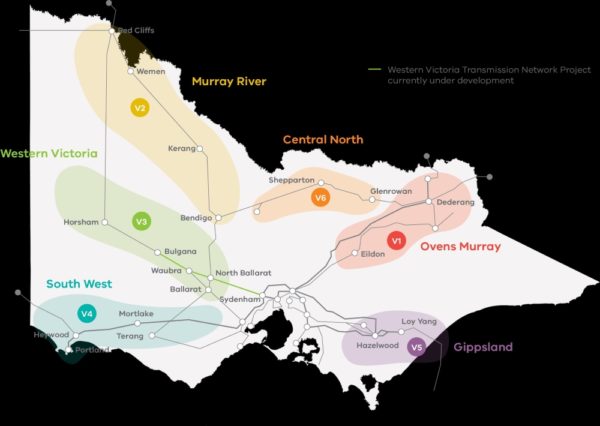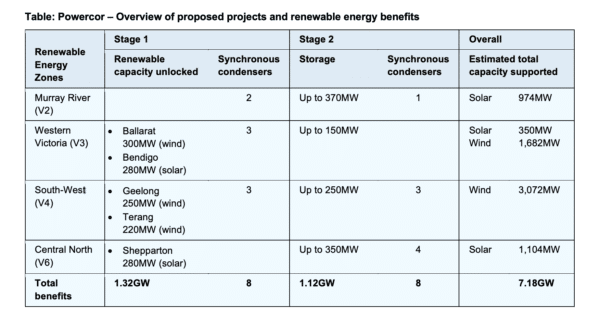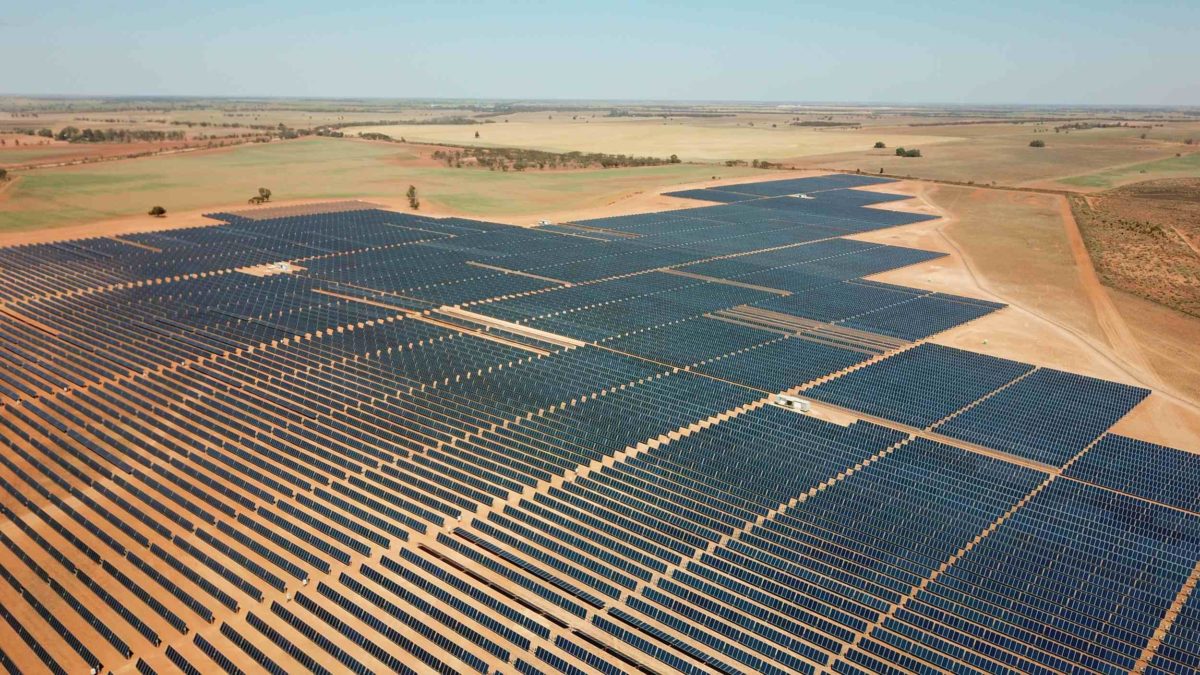Sixteen synchronous condensers, and 20 batteries with a combined capacity of up to 1.1 GW of storage capacity will be distributed across the domain of distribution network service provider, Powercor, which supplies 60% of the area of Victoria and 850,000 customers within it.
Powercor proposed the plan, to be delivered in two stages, in response to the Victorian Government’s Renewable Energy Zones (REZ) discussion paper.
It is designed to unlock more large-scale renewable connection opportunities across the four REZs (of six planned for Victoria) within Powercor’s remit — Murray River (V2), Western Victoria (V3), South-West (V4) and the Central North (V6); will support greater distributed residential and commercial rooftop penetration; and is expected to increase the reliability of the network to regional customers by an average of 22%.

Image: Victorian Government
“Connecting renewable energy at the distribution network level is fast, simple and generates greater benefits more broadly spread out at the local level,” said Mark Clarke, Powercor’s General Manager of Electricity Networks.
Powercor’s Directions Paper submission on Victorian REZs, published in March, summarised that the applications for connection by large-scale renewable generation it had worked on over the past 20 years were delivered within six months, while application for connection at transmission level could take up to two years.
Distribution network projects were also generally completed in half the time (12 months) of those at transmission level (which took at least two years).
Powercor reasoned in its announcement of the plan today that it could help the Victorian government more quickly transition to renewables, and achieve its recently strengthened emissions reduction target of 45-50% decrease in emissions by 2030, on the way to net-zero in 2050.
Interestingly, it is one of two announcements made at the start of this week that seek novel responses to the lengthy requirements imposed on investment in transmission infrastructure — the other being Energy Estate’s proposal to transport energy in the form of hydrogen from regional renewable energy hubs to manufacturing load centres. Both are evidence perhaps of “don’t build it, and the alternatives will come”.
Network-level augmentation preserves the look and feel of rural environments
Powercor’s statement today described its plan’s light footprint compared to transmission build out. It said that its proposal “requires no new easements and uses existing land and assets held by Powercor to ensure no additional impacts on the visual amenity of communities or local agricultural or natural environments.”
At the Smart Energy Summit last week, Anh Mai, the Executive Director for REZ’s in Victoria, and Chloe Hicks, Director of Energy Infrastructure and Zones in New South Wales, both emphasised the importance of understanding local communities’ perspectives on the transition to renewable energy embodied in REZ development — specifically the impacts it will have on their experience of life in regional Australia.
It’s vital, the two directors said, that people in REZ areas experience the benefits of Renewable Energy Zones, in a way that more than compensates for the disturbance and change that they will bring.
“The real opportunities come from creating jobs and network capacity that will benefit a large number of diverse communities,” says Clarke of Powercor’s network-supporting infrastructure.
Getting in synchons
The first stage of the Powercor plan is to unlock 1.3 GW of renewable generation capacity by 2025, with some of that capacity delivered within 12 months at an estimated cost of $93 million per GW of capacity unlocked.
Stage 1 centres around the strategic positioning of eight synchronous condensers to ensure system strength on the sub-transmission network, providing greater redundancy to support connection of many of the 2.3 GW of active connection enquiries or applications for solar and wind projects currently under consideration by Powercor.
It will also include augmentation of Powercor’s 66 kV network to enable a greater number of solar and wind projects to connect, especially in the Geelong, Shepparton, Terang, Ballarat and Bendigo regions.
These improvements to the network are also expected to have a positive impact on transmission network developments as the benefits conferred by synchronous condensers can be shared by generators on either transmission or distribution lines. Powercor also said its program of work will complement construction of new transmission-level investments.
A small army of batteries at substation level
Stage 2 of the Powercor rollout will see installation of another eight synchons, but centres on the installation of some 20 large batteries with a total of up to 1.12 GW capacity, positioned within or beside existing zone power stations on the network.
“These assets,” said Powercor’s Directions Paper, will “provide further benefits to regional communities, particularly in locations where traditional augmentation cannot be justified via the Australian Energy Regulator’s investment frameworks”.
It identifies optimum positions for the batteries to benefit from being close to customers in Njill, Charam, Cobram, Robinvale, Boundary Bend and Ouyen. “This storage will also be of higher value in the market, given its closer proximity to end customer load,” said the paper.
The Powercor network supplies 11,200 medium commercial and industrial businesses and 106,000 small to medium businesses concentrated in sectors such as health care, social assistance, agriculture, forestry and fishing, which are calculated when combined to generate 25% of Victoria’s gross domestic product — an economically as well as socially important customer base.

Image: Powercor
Start at the networks, please
Clarke said today that distribution networks should be considered as part of a whole-of-network solution to unlocking the state’s targeted 10 GW of new renewable energy capacity as fast as possible, and that having comparatively smaller installations connected to the distribution network would allow more projects to be built simultaneously, spreading the job opportunities across regional Victoria.
This content is protected by copyright and may not be reused. If you want to cooperate with us and would like to reuse some of our content, please contact: editors@pv-magazine.com.









By submitting this form you agree to pv magazine using your data for the purposes of publishing your comment.
Your personal data will only be disclosed or otherwise transmitted to third parties for the purposes of spam filtering or if this is necessary for technical maintenance of the website. Any other transfer to third parties will not take place unless this is justified on the basis of applicable data protection regulations or if pv magazine is legally obliged to do so.
You may revoke this consent at any time with effect for the future, in which case your personal data will be deleted immediately. Otherwise, your data will be deleted if pv magazine has processed your request or the purpose of data storage is fulfilled.
Further information on data privacy can be found in our Data Protection Policy.